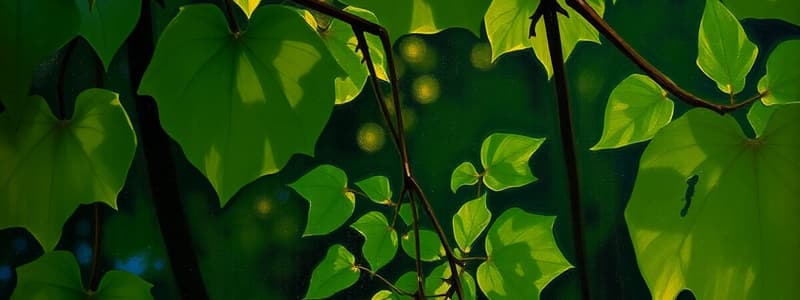Podcast
Questions and Answers
What are chloroplasts primarily responsible for?
What are chloroplasts primarily responsible for?
- Colorful pigmentation in flowers
- Photosynthesis (correct)
- Food storage
- None of the above
Plastids are found in animal cells.
Plastids are found in animal cells.
False (B)
What are the three main types of plastids?
What are the three main types of plastids?
Chloroplasts, Chromoplasts, Leucoplasts
Colorful plastids that store carotenoids are called __________.
Colorful plastids that store carotenoids are called __________.
Match the following types of plastids with their characteristics:
Match the following types of plastids with their characteristics:
What is the primary function of chlorophyll found in chloroplasts?
What is the primary function of chlorophyll found in chloroplasts?
Chloroplasts can be found in animal cells.
Chloroplasts can be found in animal cells.
What are the two types of pigments stored in chromoplasts?
What are the two types of pigments stored in chromoplasts?
Leucoplasts primarily store food in the form of _____ .
Leucoplasts primarily store food in the form of _____ .
Match the following plastids with their characteristics:
Match the following plastids with their characteristics:
Flashcards
Plastids
Plastids
Double membrane organelles in plant cells and some protozoa that store and make food.
Chloroplasts
Chloroplasts
Photosynthetic plastids that contain chlorophyll and are responsible for photosynthesis.
Chromoplasts
Chromoplasts
Colored plastids, derived from chloroplasts, that store pigments like carotenoids.
Leucoplasts
Leucoplasts
Signup and view all the flashcards
Proplastids
Proplastids
Signup and view all the flashcards
What are chloroplasts?
What are chloroplasts?
Signup and view all the flashcards
What makes chloroplasts unique?
What makes chloroplasts unique?
Signup and view all the flashcards
What does chlorophyll do?
What does chlorophyll do?
Signup and view all the flashcards
What are chromoplasts?
What are chromoplasts?
Signup and view all the flashcards
Why are leucoplasts important?
Why are leucoplasts important?
Signup and view all the flashcards




